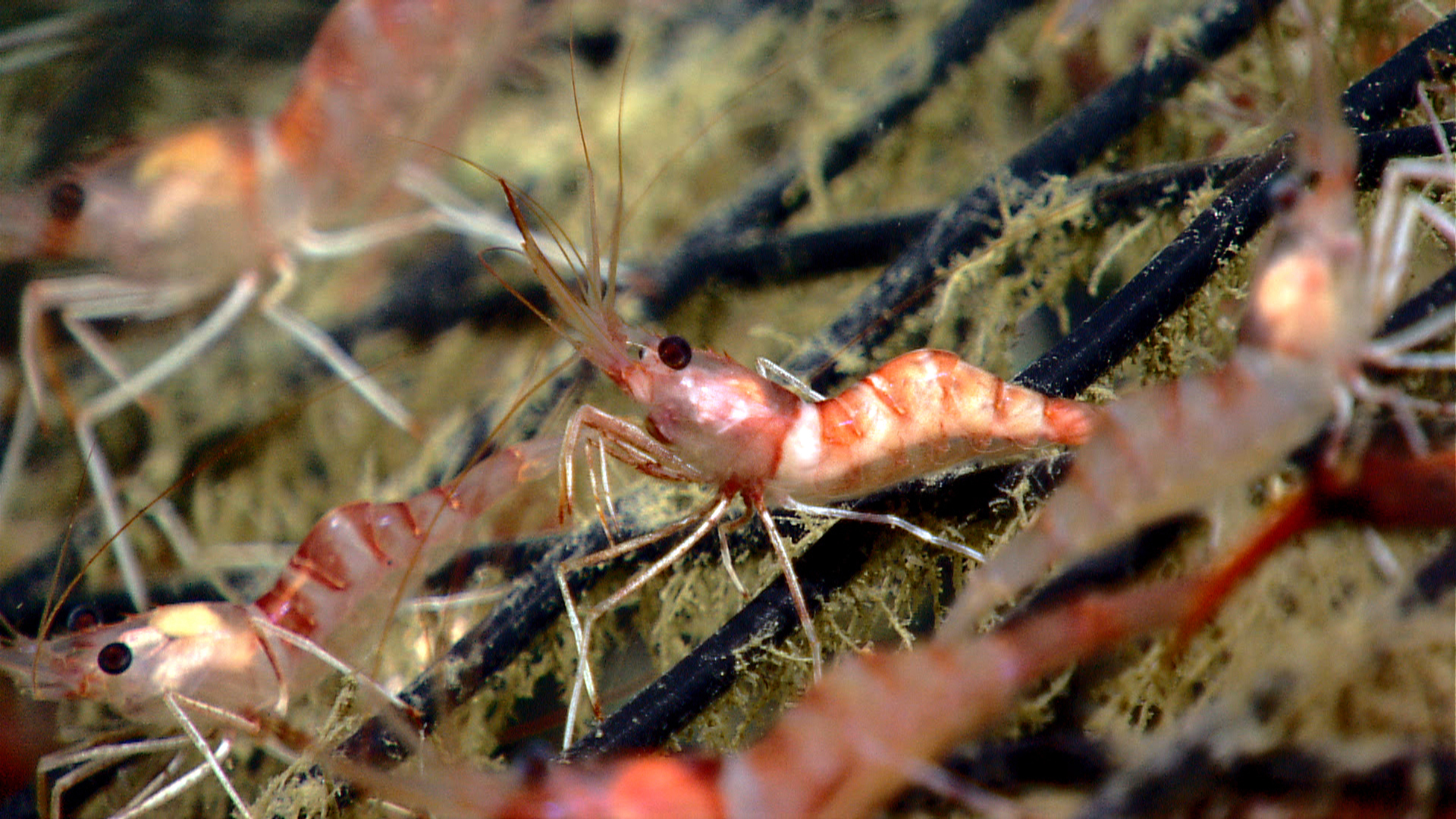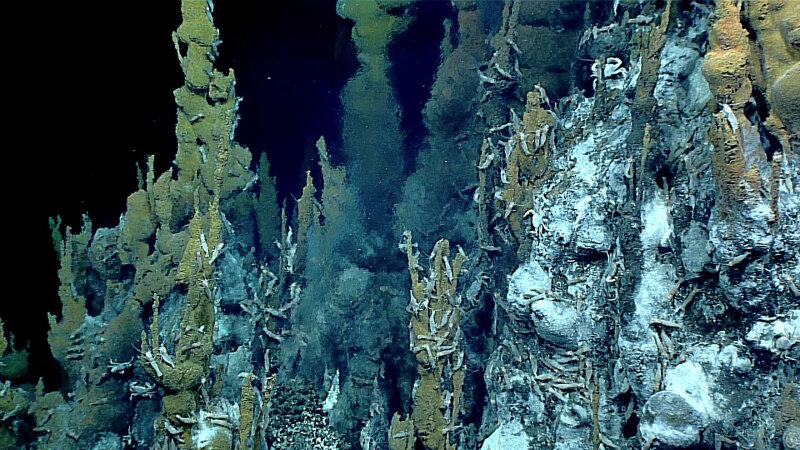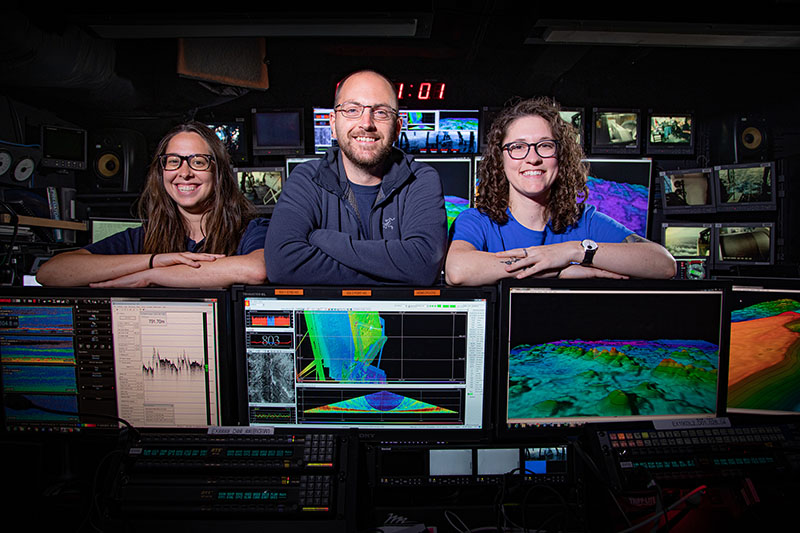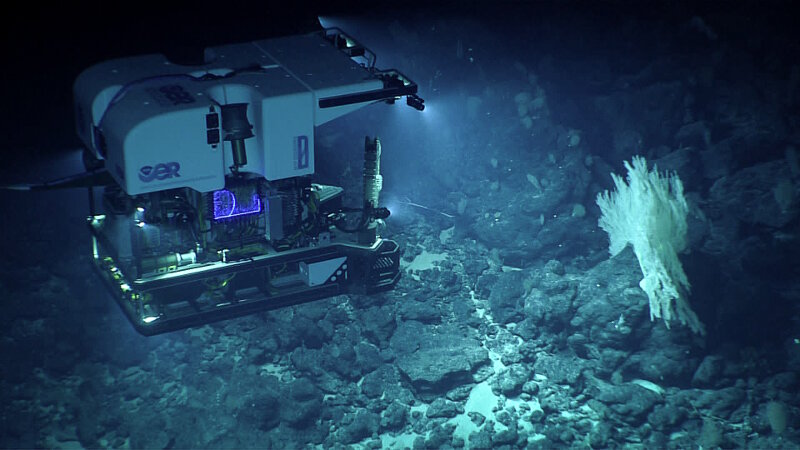
Deep-Ocean Bites
Deep-Ocean Bites is a collection of short, topical videos featuring bite-sized answers to deep-sea and open exploration questions provided by experts in the field. Dive into each of the miniseries below to learn more about various topics in ocean exploration and get an inside look into what it means to be a deep-sea scientist and explorer.

Hydrothermal Vents Miniseries
Hydrothermal Vents are found in the deep ocean near spreading centers and subduction zones. Despite being volatile environments beyond the reach of the sun, vents are oases of life. Learn more about this unique ecosystem from the experts that study it.
First discovered in 1977, hydrothermal vents are home to dynamic and diverse ecosystems. These ecosystems are found near spreading centers and subduction zones, where seawater percolates down through fissures in the ocean crust, is heated by magma, and reemerges as chemical-rich fluid, reaching 400°C (750°F) or more. As the superheated vent fluid rises, it is cooled by the surrounding ocean water and minerals begin to precipitate out, forming the tell-tale chimneys of hydrothermal vents that can rise more than 50 meters (164 feet) from the seafloor.
Here, in an unlit world without access to the sun’s energy, chemosynthesis provides the basis for the development of rich, diverse communities. Chemosynthetic deep-sea bacteria form the base of a food web that includes a significant variety of marine life.
The Deep-Ocean Bites Hydrothermal Vent Miniseries features “bite-sized” explanations about hydrothermal vent ecosystems and the communities they support provided by Roxanne Beinart, Ph.D. and Peter Girguis, Ph.D.
The Deep-Ocean Bites Hydrothermal Vent Miniseries is produced using previously recorded footage from expert interviews conducted during virtual NOAA Ocean Exploration Educator Professional Development events on various deep-sea topics from 2020 to present. The questions featured in each video were submitted by professional development participants and were answered live by ocean exploration experts. Additional topical footage was paired with interview transcripts after the fact to produce each of the short videos in the collection above.
Learn more about NOAA Ocean Exploration Educator Professional Development Opportunities and register for the next event today for the opportunity to ask an expert live.

Ocean Exploration Careers Miniseries
Despite the fact that the ocean covers approximately 70% of Earth’s surface, much of it remains unexplored and not fully understood. Ocean Exploration is an interdisciplinary career field made up of researchers from various scientific disciplines, engineers, educators, science communicators, and more, working together to close gaps in our basic understanding of the biggest habitat on this planet.
The ocean covers approximately 70% of the Earth’s surface. Yet, most of it remains unexplored, uncharacterized, and unknown.
Ocean exploration is about making discoveries, searching for things that are unusual and unexpected, and filling in knowledge gaps. Oceanographic researchers, archaeologists, engineers, seafloor mappers, conservationists, educators, communicators, policy makers, and more, work together in this multidisciplinary field to explore the ocean, collecting a variety of data and samples necessary for us to understand our planet’s largest habitat.
The Deep-Ocean Bites Ocean Exploration Careers Miniseries features “bite-sized” stories from ocean exploration experts about the work that they do and the paths they took to become explorers of our unknown ocean.
The Deep-Ocean Bites Hydrothermal Vent Miniseries is produced using previously recorded footage from expert interviews conducted during virtual NOAA Ocean Exploration Educator Professional Development events on various deep-sea topics from 2020 to present. The questions featured in each video were submitted by professional development participants and were answered live by ocean exploration experts. Additional topical footage was paired with interview transcripts after the fact to produce each of the short videos in the collection above.
Learn more about NOAA Ocean Exploration Educator Professional Development Opportunities and register for the next event today for the opportunity to ask an expert live.

Underwater Robots Miniseries
Underwater robots, such as remotely operated vehicles and autonomous underwater vehicles, are essential tools for ocean exploration. These robots can explore areas of the ocean that are too dangerous or too difficult for humans to go. Underwater robots come in a variety of shapes and sizes and can be outfitted with numerous sensors and tools to collect data and samples needed to better understand deep-sea environments.
We know less about the ocean floor than we do about the surface of the Moon and Mars. This is due to the many challenges that explorers must overcome to study the deep sea, including high pressure, low temperature, and complete darkness. Underwater robots are essential tools for ocean exploration, reaching areas of the ocean that are too dangerous or too difficult for humans to go. Remotely operated vehicles (ROVs) are underwater robots that are tethered to a ship on the ocean’s surface via a long power and communications cable, allowing pilots on board the ship to see what the robot is exploring and control it from above. Autonomous underwater vehicles (AUVs) are not tethered to the ship and instead are controlled by a pre-programmed computer within the vehicle. Both types of underwater robots are highly customizable to the type of environments and research questions they are being used to explore. They are commonly outfitted with bright lights and high-definition cameras to capture what deep-sea environments look like. Additionally, ROVs and AUVs can be outfitted with a variety of sensors and tools to collect data and samples to better understand the deep ocean. Ocean engineers and pilots help to design, build, and even “fly” these underwater robots.
The Deep-Ocean Bites Hydrothermal Vent Miniseries is produced using previously recorded footage from expert interviews conducted during virtual NOAA Ocean Exploration Educator Professional Development events on various deep-sea topics from 2020 to present. The questions featured in each video were submitted by professional development participants and were answered live by ocean exploration experts. Additional topical footage was paired with interview transcripts after the fact to produce each of the short videos in the collection above.
Learn more about NOAA Ocean Exploration Educator Professional Development Opportunities and register for the next event today for the opportunity to ask an expert live.
Each Deep-Ocean Bites video is produced using previously recorded footage from expert interviews conducted during virtual NOAA Ocean Exploration Educator Professional Development events. The questions featured in each video were submitted by professional development participants and were answered live by ocean exploration experts. Additional topical footage was paired with interview transcripts after the fact to produce each of the short videos in the collections above.
The Deep-Ocean Bites collections are developed by a NOAA Ocean Exploration Explorer-in-Training intern completing a 10-week, remote Exploration Education, Media, and Science Communication internship opportunity.
